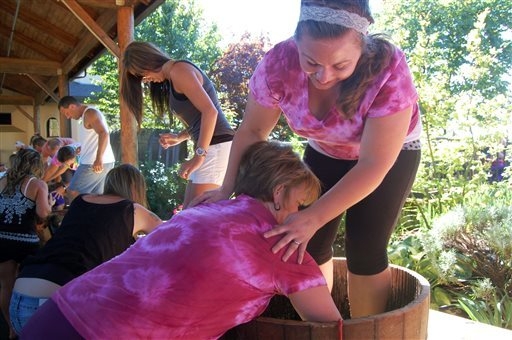Oregon grape stomps for fun, not wine

TURNER, Ore. — There is one thing that the people at Willamette Valley Vineyards want you to know about their annual grape stomp. It is a very important point, one they make several times.
“We do not use the grapes that people stomp in our wines,” said Wende Bennette. “Please tell everyone that.”
She points to a pile of grapes in a high-sided wooden bucket. “That juice,” she jabs her finger, “doesn’t leave their feet and go into the barrel. Please, please, make sure everyone knows that.”
OK, Wende.
Bennette’s title at the vineyard is “wine ambassador,” but in practical terms that means she was the woman with the megaphone on a recent Saturday holding court before 10 teams stomping as much juice from throwaway chardonnay grapes as possible.
The wine industry didn’t take off here until the 1960s, but now Oregon’s Willamette Valley is host to a dozen or more of these grape stomps each fall. Some wineries tie them in to Oktoberfests — lederhosen, polka bands, the works. Others, like the one on this hilly sliver overlooking acres of farmland, are focused entirely on the wine.
Either way, the events serve two purposes. Like Oktoberfests and other autumn harvest-themed events, grape stomps attract tourists — both as participants and as spectators. But they also give winemakers a way to purge their nervousness in early fall, when grapes should be ready for harvesting but remain vulnerable to bad weather.
“THREE! TWO! ONE! GO!” Bennette shouted as the two-person teams got to work here at Oregon’s state Grape Stomp Championship. Barefooted stompers smashed the grapes, while the scrapers did the real work, going elbow-deep in the buckets to unclog drains of skins while ducking teammates’ knees and getting grape guts in their faces.
Techniques varied. Some stompers ran in place. Some slid from side to side. Others did a kind of jig, trying to crush the biggest clusters of grapes. Some seemed to take personal offense at the grape’s existence, angrily plunging their feet ankle-deep in the muck, as if the fruit had said something mean about their mothers.
Competitions are timed; each team’s yield is measured, and the team that produces the most juice wins. The winners of this event, Lisa and Dan Soete, competing as Stomping Studs, have taken several titles here before. Their win at Willamette in the Oregon state finals qualified them to compete in the World Championship Grape Stomp, Oct. 3-5 in Santa Rosa, California.
Despite their success in Oregon, the pair had a dirty secret: They’re actually from Washington, joining dozens of others who came from out of state to compete. “We do pretty well here,” said Lisa Soete. “There’s a technique, but I can’t say what it is. How’d we keep winning if I did?”
Grape stomps weren’t always pure spectacle. Historically, that was how winemakers got the grapes to give up their juice. The Romans even depicted a grape stomp on a fourth-century sarcophagus. The French call it “pigeage,” pronounced “peej-AHJH,” which means punching down, a reference to the process of pushing down the skein of grape skins that forms on the surface of a vat of fruit after the initial crush.
As it turns out, the grapes that weren’t sent for stomping are having a pretty good year. Early reports after a hot summer predict an enormous yield this year, portending good tidings for this stretch of wine country.
“We’re hopeful,” Bennette said. The grape stomp “is a reminder of how close we are to what we make.”